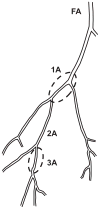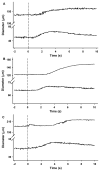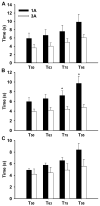Rapid vasodilation in isolated skeletal muscle arterioles: impact of branch order
- PMID: 20163535
- PMCID: PMC2943204
- DOI: 10.1111/j.1549-8719.2009.00005.x
Rapid vasodilation in isolated skeletal muscle arterioles: impact of branch order
Abstract
We tested the hypothesis that segmental differences in the responsiveness and time course of vasodilation to metabolic signals putatively involved in rapid onset vasodilation (ROV) at the start of exercise exist within the skeletal muscle vasculature. Cannulated first-order (1As) and third-order arterioles (3As) of the rat gastrocnemius (G) muscle were exposed to cumulative doses of KCl, acetylcholine (Ach), or adenosine (Ado). In addition, time course and magnitude of vasodilation to localized application of these agonists were determined. 1As and 3As dilated similarly to incremental doses of the agonists. Continuous monitoring of internal diameter revealed a fast and transient dilatory response to microinjections of the agonists, with an average time delay (TD) before the onset of vasodilation of 2.8 +/- 0.2 seconds (1As: 3.0 +/- 0.3 seconds and 3As: 2.6 +/- 0.3 seconds) and time-to-peak (TP) of 8.2 +/- 0.7 seconds (1As: 10.3 +/- 1 seconds and 3As:5.7 +/- 0.5 seconds). No significant differences were detected for all parameters between 1As and 3As for KCl or Ado application, while 1As had a significantly longer TP and greater peak dilation than 3As to Ach. These findings demonstrate that 1As and 3As from the rat G muscle appear to have similar responsiveness to vasoactive agonists. Furthermore, the average TD before vasodilation supports a role for metabolic signals as contributors to the ROV.
Conflict of interest statement
There are no conflicts of interest to disclose.
Figures






Similar articles
-
Time course of vasodilatory responses in skeletal muscle arterioles: role in hyperemia at onset of exercise.Am J Physiol Heart Circ Physiol. 2000 Oct;279(4):H1715-23. doi: 10.1152/ajpheart.2000.279.4.H1715. Am J Physiol Heart Circ Physiol. 2000. PMID: 11009459
-
Mechanisms of flow and ACh-induced dilation in rat soleus arterioles are altered by hindlimb unweighting.J Appl Physiol (1985). 2002 Mar;92(3):901-11. doi: 10.1152/japplphysiol.00642.2001. J Appl Physiol (1985). 2002. PMID: 11842020
-
Interval sprint training enhances endothelial function and eNOS content in some arteries that perfuse white gastrocnemius muscle.J Appl Physiol (1985). 2004 Jan;96(1):233-44. doi: 10.1152/japplphysiol.00105.2003. Epub 2003 Aug 15. J Appl Physiol (1985). 2004. PMID: 12923113
-
Hindlimb unweighting alters endothelium-dependent vasodilation and ecNOS expression in soleus arterioles.J Appl Physiol (1985). 2000 Oct;89(4):1483-90. doi: 10.1152/jappl.2000.89.4.1483. J Appl Physiol (1985). 2000. PMID: 11007586
-
Calcium-activated potassium channel-mediated arteriolar relaxation during endotoxic shock.Shock. 1997 Apr;7(4):294-9. doi: 10.1097/00024382-199704000-00009. Shock. 1997. PMID: 9110416
Cited by
-
The cardiovascular response to passive movement is joint dependent.Physiol Rep. 2016 Mar;4(5):e12721. doi: 10.14814/phy2.12721. Physiol Rep. 2016. PMID: 26997626 Free PMC article.
-
Control of muscle blood flow during exercise: local factors and integrative mechanisms.Acta Physiol (Oxf). 2010 Aug;199(4):349-65. doi: 10.1111/j.1748-1716.2010.02129.x. Epub 2010 Mar 26. Acta Physiol (Oxf). 2010. PMID: 20353492 Free PMC article. Review.
-
Dynamics of middle cerebral artery blood flow velocity during moderate-intensity exercise.J Appl Physiol (1985). 2017 May 1;122(5):1125-1133. doi: 10.1152/japplphysiol.00995.2016. Epub 2017 Mar 9. J Appl Physiol (1985). 2017. PMID: 28280106 Free PMC article.
-
Accelerated Muscle Deoxygenation in Aerobically Fit Subjects During Exhaustive Exercise Is Associated With the ACE Insertion Allele.Front Sports Act Living. 2022 Feb 28;4:814975. doi: 10.3389/fspor.2022.814975. eCollection 2022. Front Sports Act Living. 2022. PMID: 35295536 Free PMC article.
-
Commentaries on viewpoint: A paradigm shift for local blood flow regulation.J Appl Physiol (1985). 2014 Mar 15;116(6):706-7. doi: 10.1152/japplphysiol.01360.2013. J Appl Physiol (1985). 2014. PMID: 24633729 Free PMC article. No abstract available.
References
-
- Anderson KM, Faber JE. Differential sensitivity of arteriolar alpha 1- and alpha 2-adrenoceptor constriction to metabolic inhibition during rat skeletal muscle contraction. Circ Res. 1991;69:174–184. - PubMed
-
- Bauer TA, Reusch JE, Levi M, Regensteiner JG. Skeletal muscle deoxygenation after the onset of moderate exercise suggests slowed microvascular blood flow kinetics in type 2 diabetes. Diabetes Care. 2007;30:2880–2885. - PubMed
-
- Bearden SE. Advancing age produces sex differences in vasomotor kinetics during and after skeletal muscle contraction. Am J Physiol Regul Integr Comp Physiol. 2007;293:R1274–1279. - PubMed
Publication types
MeSH terms
Substances
Grants and funding
LinkOut - more resources
Full Text Sources

